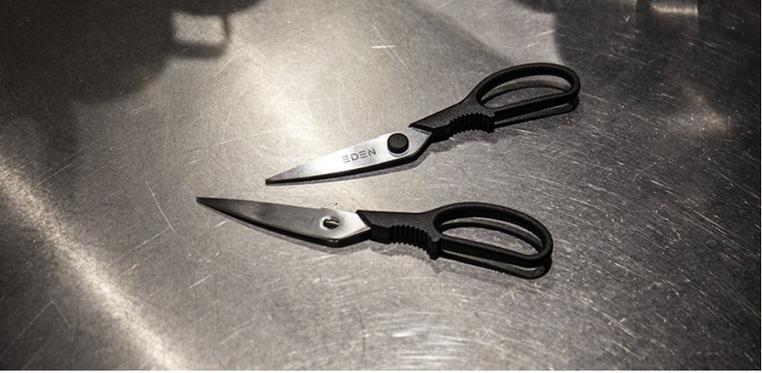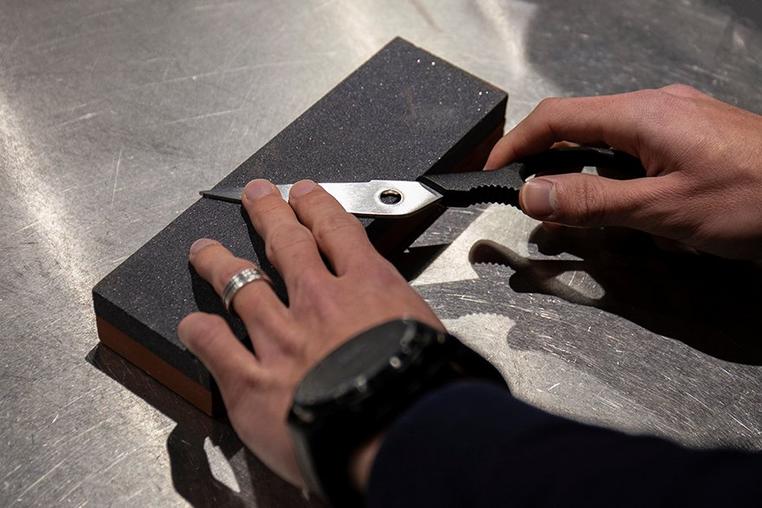How do you sharpen scissors?
You might not realize it but your pair of kitchen scissors is one of the most frequently used tools in the kitchen. You use it to cut paper, cardboard or aluminium foil, but perhaps also herbs, vegetables and even meat and fish. Not that surprising then that in time the blades of scissors lose their sharpness. You notice it when you need to apply more pressure and you can no longer cut from the beak to the tip of the scissors in one go. In that case there is only one thing left to do: sharpen your pair of scissors.
For sharpening scissors the same applies as when sharpening knives: you can easily do it yourself. How you do it mostly depends on the state of the edges. If you notice that cutting is not that easy anymore but still possible, grinding paper could sometimes already be enough. Use both sides of the pair to cut five to ten times in a piece of grinding paper (the grain size is not that relevant) and you will notice that the pair will work a whole lot better. However, if you are looking for razor-sharp results or if your pair is so blunt you won’t be able to cut through a piece of paper it is time to bring out the big guns. To bring out your sharpening stone.
Sharpening on a sharpening stone
Sharpening scissors on a sharpening stone is not the same as when you sharpen knives. After all, most (kitchen)knives, aside from Japanese knives, have a two-sided blade. The edge will have a V-shape. Scissors are different as they have two blades. Both are ‘only’ sharpened on the inside, also called a ‘chisel grind’. If you want to sharpen a pair of scissors it is best if you take it apart and use both sides as individual ‘knives’. As such sharpening the entire edge will be a lot easier. In addition, you ensure that while sharpening you don’t cut yourself with the other side of the pair.
You start by choosing the right sharpening stone. If you only have to slightly sharpen the pair you should use a fine stone (grainsize 1000 or higher). If your pair is relatively blunt you should first repair the edge with a coarser sharpening stone. Think of grainsizes 100 to 400. Considering the fact that almost all scissors are made from stainless steel you can use any type of abrasive. For quick results you could choose diamond. An advantage is that the sharpening stone won’t become hollow and will last a long time. However, if you have more time and are you looking for finer results than what you might get from diamond sharpening stones, you could also use ceramics, aluminium oxide or novaculite.
Sharpening the inside of the blade
Found the right stone? If so it is time to sharpen the inside of the first blade. We are not talking about the edge, but about the flat insides. Frequent use of scissors during which both blades move over each other could, after all, leave you with irregular wear and tear. It is something you want to restore first. In addition, this way you also remove any potential rust.
After adding water to the sharpening stone you place the blade of the scissors flat on top of the stone. In a controlled manner you move it from the beak (the place where the blade runs over in the handle) up to the tip over the sharpening stone. Use the entire length of the stone and do not apply too much pressure. The stone should do the work. Repeat this until – if you are dealing with it – all rust has been removed. You could also use a marker to mark the entire blade. If you have removed all of the markings the blade will be completely flat.
Next: the edge
Afterwards it is time to handle the edge. The advantage of sharpening scissors in comparison to a knife is that the edge is relatively broad and properly visible. As a result the right sharpening angle has already been chosen for you. You place the blade on the sharpening stone with an angle to make sure the entire edge comes into contact with the stone. Now you need to make the same movement from the beak towards the tip, using the entire sharpening surface. Depending on how blunt the pair was a burr will emerge (the blunter the pair, the larger the chances of a burr). If you notice a burr you can stop sharpening. Was your pair still relatively sharp before you started sharpening? If so you can mark the edge with a marker to make sure you removed enough material.
Is the blade sharp enough? Repeat the process with the other half of the scissors. If burrs have emerged you can easily remove them. Put both pieces back together and make a couple of cutting movements. By allowing the blades to move over each other the burrs will disappear.
Other sharpening methods
Were you successful? Great! Of course there are many other ways to sharpen your scissors. Work Sharp, for instance, produces electric sharpening machines you can use to sharpen scissors. Take the Work Sharp Ken Onion edition a type of small professional sharpening machine with a guiding system. With it you can sharpen almost any tool. Another option is the Work Sharp Knife & Tool Sharpener that comes with a special piece to sharpen (for instance) scissors.
Are you the happy owner of an Edge Pro Apex sharpening system and are you looking to sharpen scissors? If so it could be an idea to purchase the special adapter to be able to sharpen scissors. Perhaps a slightly more expensive option, but with it you can choose the angle of your liking. In that respect the electric sharpening machines don’t have that much options.
Another sharpening system that could be useful is the Spyderco 204MF Sharpmaker. This system comes with an extensive selection of sharpening steels that can also be purchases individually. The Spyderco is an easy to use system. However, it has to be said that extremely blunt scissors (and knives) will probably never be as sharp as they were before if you use this system. If this is the case we still recommend the use of, for instance, diamond sharpening stones.
You could also use a sharpening steel but the disadvantage is that this tool is relatively unstable. It is quite difficult to maintain the right sharpening angle. As a result chances are that the scissors are sharpened unevenly. Pull-through sharpeners are not the right choice as they sharpen both sides of the blade and when you use scissors that is of course not the intention.
In short: there are different ways to sharpen your scissors. Want to learn more about sharpening in general? Learn more about the basic principles of sharpening here!










?%24center=center&%24poi=poi&%24product-image%24=&fmt=auto&h=500&poi=%7B%24this.metadata.pointOfInterest.x%7D%2C%7B%24this.metadata.pointOfInterest.y%7D%2C%7B%24this.metadata.pointOfInterest.w%7D%2C%7B%24this.metadata.pointOfInterest.h%7D&scaleFit=%7B%28%24this.metadata.pointOfInterest%29%3F%24poi%3A%24center%7D&sm=c&w=1208)